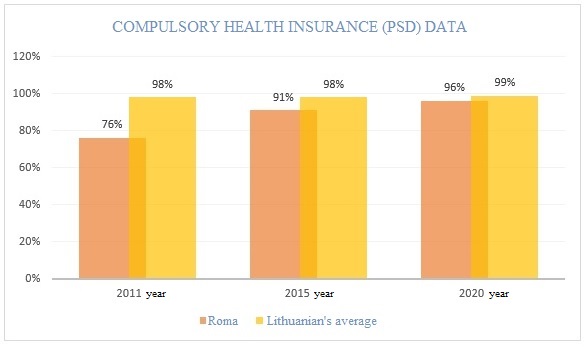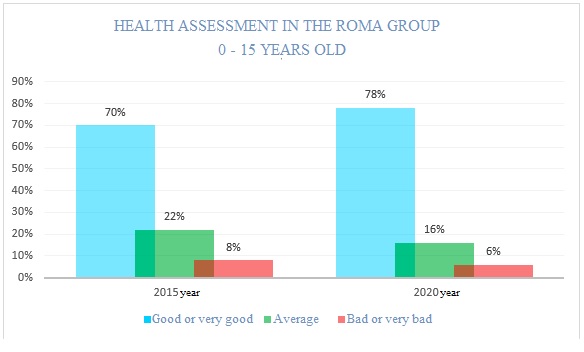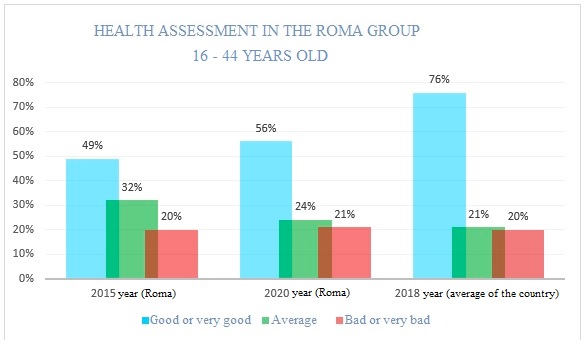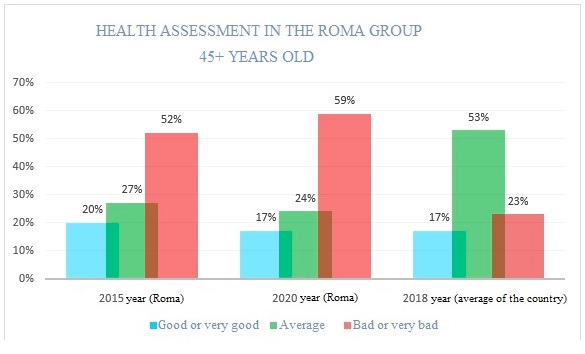Health Care System
Availability of health care services for persons of Roma nationality
All persons covered by compulsory health insurance (Privalomasis sveikatos draudimas – PSD) have the right to receive treatment and health care services in Lithuania without additional fees. This right is acquired in exchange for continuously paid monthly PSD contributions of a fixed amount. PSD contributions are paid by the state for residents who belong to socially sensitive population groups. The absolute majority of persons of Roma nationality are covered by compulsory health insurance and receive the necessary health care services.
Subjective assessment of health
Based on the data of the study “The Situation of the persons of Roma nationality” (2020), in comparison with the year 2015 the subjective assessment of one’s health has slightly improved in the Roma group of children under 15 years old and adults of working age (16-44 years old), the general assessment of their health status slightly improved as well – there was an increased number of answers about the health ‘good’ or ‘very good’, and a decrease of the number of answers ‘average’. In the same period of time, there was an increase in the number of elderly (45 years old and older) Roma people who rated their health as ‘bad’ and ‘very bad’. In comparison with the indicators of the entire population of Lithuania, there are more people in the Roma group who rate their health poorly, especially in the working age and older age groups. In both groups – the Roma and the rest of population of Lithuania – a statistically significant relationship between age and health assessment is found: the older the participants of the study, the higher the probability that they will assess their health as ‘bad’ or ‘very bad’. However, the strength of the relationship among all adult Lithuanian residents is higher than in the Roma group – this means that there are other factors, not related to age and natural aging, that lead to a worse assessment of health among the Roma.
The coverage of vaccination coverage of Roma children
The study “THE STUDY OF THE DATA ANALYSIS OF VACCINATION VOLUME WHERE THE TARGET GROUP WAS CHILDREN” was conducted on the year 2018. One of the tasks of the research is to assess the coverage of vaccination against tuberculosis, hepatitis B, pneumococcal infection, measles, epidemic parotitis, rubella, diphtheria, tetanus, whooping cough, poliomyelitis, Haemophilus influenzae (type B) among Roma children living in Lithuania under the age of 18. During the study, it was found that Roma children living in Lithuania under the age of 18 are insufficiently vaccinated against tuberculosis, hepatitis B, pneumococcal infection, measles, epidemic parotitis, rubella, diphtheria, tetanus, whooping cough, poliomyelitis, Haemophilus influenzae type B, and the vaccination coverage is significantly lower than among the other children in the country.
“THE STUDY OF THE DATA ANALYSIS OF VACCINATION VOLUME WHERE THE TARGET GROUP WAS CHILDREN” (LT)



